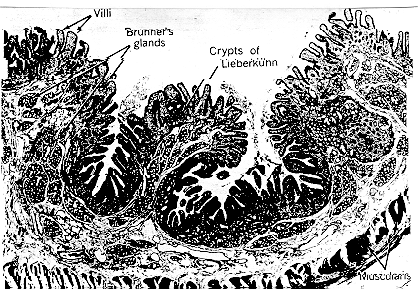The volume--Hypovolemic Shock
*The above graphic illustrates venomotor tone, i.e., the state of muscle contraction around the veins. If the muscles constrict more blood is returned to the right ventricle (increased preload), thus more cardiac output will be possible. During inspiration there is a slight drop in the thoracic transpulmonary pressure (from -2 to -5) which causes a sucking action of blood back toward the heart, i.e., the respiratory or thoracic pump.
Shock resulting from the loss of blood or body fluids may result from a variety of pathological entities including:
1) Hemorrhagic Shock-- is the Loss of Blood from external or internal bleeding. Examples of external bleeding are trauma from knives, gunshot wounds, MVA'a, fights and all the wonderful things that human beings do to each other. Internal bleeding can be from abdominal injuries such as ulcers, openings in surgical sites, bleeding into the meninges from brain injuries, etc.
graphic of IVH1
*The graphic below illustrates a form of Hemorrhagic Shock known as Traumatic Shock. Traumatic Shock always involves crushing injuries. Another form of Hemorrhagic Shock referred to above is Surgical or wound Shock. The patient below has both Traumatic Shock and Surgical Shock (from the placement of a chest tube) and internal and external bleeding.
2) Severe Dehydration-- is Loss of Water and Sodium through perspiration or loss of body temperature control. This is most likely to happen at the extremes of age as in the elderly or infants. Infants are likely to experience severe dehydration due to vomiting and diarrhea.

*The above graphic illustrates a dehydrated infant experiencing respiratory distress. The arrow points to intercostal retractions.
3) Burn Shock--is the exudation of plasma from burned skin surfaces. Patients with a large amount of their body surface covered with second and third degree burns can suffer from dehydration and burn shock together. They require 4-5 liters of IV fluids a day until their skin is replaced.

*The above graphic illustrates a patient with second and third degree burns on his back. Nosocomial infection and dehydration leading to hypotension are the greatest fears in this patient.
4) Intestinal Obstruction Shock is the loss of plasma from the intestinal capillaries, the internal bowel wall and the lumen. This may be due to surgical manipulation or internal bleeding
.*The graphic below depicts the duodenum, the first part of the small bowel. Notice the villi for absorption and the outer layer of smooth muscle for peristalsis. Surgeries for ulcers are common in this area.

As intravascular volume is depleted, venous return begins to suffer. The peripheral and visceral vasculature vasoconstrict in an attempt to increase venous return, and the skin becomes cool and pale.
CVP is the first Swan-Ganz value to drop followed by PA, followed by the PCWP as volume depletion continues. Thus both Hemorrhagic Shock and Low Resistance Shock have the same sequence of falling Swan-Ganz values. The way to tell them apart is by the skin reaction. If the skin is hot and flushed, low resistance shock is taking place, while if the skin is cool and pale, Hypovolemic Shock is occurring.
Return to Shock Menu